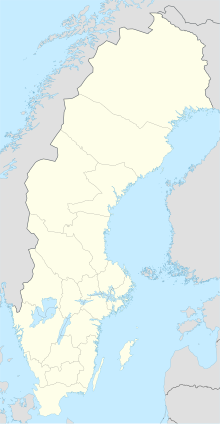Draft:Kalix Airfield
 | Review waiting, please be patient.
This may take 8 weeks or more, since drafts are reviewed in no specific order. There are 1,769 pending submissions waiting for review.
Where to get help
How to improve a draft
You can also browse Wikipedia:Featured articles and Wikipedia:Good articles to find examples of Wikipedia's best writing on topics similar to your proposed article. Improving your odds of a speedy review To improve your odds of a faster review, tag your draft with relevant WikiProject tags using the button below. This will let reviewers know a new draft has been submitted in their area of interest. For instance, if you wrote about a female astronomer, you would want to add the Biography, Astronomy, and Women scientists tags. Editor resources
Reviewer tools
|
Kalix Airfield F21K Kalix | |||||||||||||||||||
|---|---|---|---|---|---|---|---|---|---|---|---|---|---|---|---|---|---|---|---|
 Aerial view of Kalix airfield 1944s | |||||||||||||||||||
| Summary | |||||||||||||||||||
| Airport type | Former Air Base | ||||||||||||||||||
| Serves | Kalix, Norrbotten | ||||||||||||||||||
| Location | Kalix, Norrbotten, Sweden | ||||||||||||||||||
| Coordinates | 65°51′02″N 23°11′14″E / 65.85056°N 23.18722°E | ||||||||||||||||||
| Map | |||||||||||||||||||
 | |||||||||||||||||||
| Runways | |||||||||||||||||||
| |||||||||||||||||||
The Kalix Airfield (also known as Kalixfält or F21K Kalix) was located in Sweden, 780 km north of Stockholm. Built between 1936-1941 as part of an unemployment project, it was taken over by the Swedish Air Force in 1942. The airfield had three hardened runways and hosted reconnaissance missions during WWII.
History
[edit]Kalix is a municipality in northern Sweden, which played a strategic role during the Cold War as part of the Swedish defense system. This area housed installations like airfields and fortified structures designed to support Sweden's neutrality and defensive capabilities during heightened global tensions. The Kalix Line, a defensive line of fortifications in the region, was particularly significant in guarding against potential invasions[1]
Constructed between 1936 and 1941 as a civil airfield through an unemployment relief project, it was taken over by the Swedish Air Force in 1942. Between 1943 and 1944, the airfield was expanded to include three hardened runways, each measuring between 750 and 800 meters.[2]
World War II
[edit]During World War II within the context of Sweden's neutral status. The airfield was part of Sweden's strategic defense efforts, which involved establishing military readiness to prevent incursions by warring nations. The airfield was associated with Sweden's broader defensive system during the war, including fortifications like the “Kalix Line,” constructed to protect the country from potential attacks from both Germany and the Soviet Union.[3]
The Kalix Line, a defensive network near the Finnish border, was supported by airfields like Kalix to ensure logistical and tactical flexibility. While Sweden avoided direct combat, facilities like this were critical in monitoring and deterring potential threats during the tense war period. Today, remnants of these efforts, including Kalix's military installations, are of historical significance and are preserved in military museums.[3]
In September 1944, the reconnaissance unit 5./F3 was stationed at Kalixfält with eight S17B aircraft and one S14 (Fieseler Storch). Their mission was to monitor the German retreat from Finland. By late October 1944, operations moved to Kiruna, although the 4th group of F3 (IV/F3) remained at Kalixfält.[2]
Cold-War
[edit]During the Cold War, Norrbotten held significant strategic importance due to its close proximity to the Soviet Union. The region was home to several military bases and critical infrastructure that supported Swedish defense operations during this period.[4]
Norrbotten saw a substantial military presence, with both Swedish and foreign bases located throughout the area. For instance, American radar stations were stationed in Vidsel and Jokkmokk, while Swedish air defense bases were situated in Kalix, Boden, and Luleå. Additionally, the Swedish Air Force operated several bases in Norrbotten, including in Kiruna and Luleå.[4]
There were initial plans for Kalix to develop a large, expanded airfield that would serve both military and civilian purposes for Norrbotten. However, the expansion ultimately took place in Luleå instead. In the 1950s, the arrival of jet aircraft made the airfield more vulnerable, as it could be quickly overtaken by enemy forces or targeted in a bombing attack. According to defense plans, the airfield was to be protected by the 638 Defense Company from the Kalix airfield platoon, which fell under the Kalix defense area. In the early 1960s, when the aviation administration no longer required the airfield, the state-owned portions were sold to the Nederkalix municipality.[5][4]
Post-War
[edit]After World War II ended in 1945, Kalix Airfield served as a practice field but saw limited use and did not receive a designated field number. The exact date of its closure is unknown. By the 1980s and 1990s, with the decline of the Soviet threat and advancements in air defense technology, Kalix Airfield, like many others in Sweden, saw a reduction in military activity.[2][1]
Decommissioning & Closure
[edit]Following its decommissioning, much of the airfield was developed into the city of Kalix. However, remnants of the runways remain, with Runway 14/32 being the most intact, now forming a boundary between residential and commercial areas.
References
[edit]- ^ a b "Kalix in Cold War". Retrieved 30 October 2024.
- ^ a b c "Kalix Airfield". Forgotten Airfields. Retrieved 5 December 2024.
- ^ a b "Military Heritage: Kalix Line Museum". Retrieved 1 December 2024.
- ^ a b c "Norbotten and Cold-War". Retrieved 2 December 2024.
- ^ The Riksdag administration. "Proposition document". Retrieved 5 December 2024.

